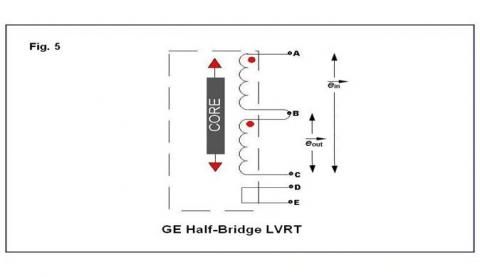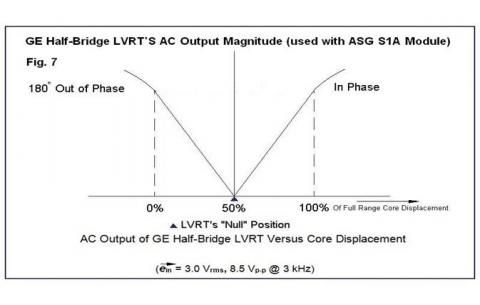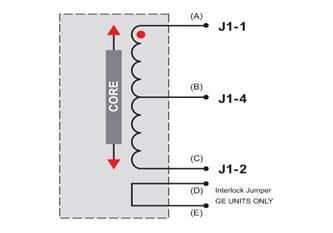How to use GE position sensors with third-party LVDT signal conditioners - II

The first section of this article shows how GE LVDTs differ from conventional LVDTs, and how to operate them with an S1A LVDT signal conditioner module. In this article,
the author discusses the functioning of GE half-bridge sensors, and how they can be used with an S1A signal conditioner.
Operating GE Inductive Half-bridge Position Sensors with an S1A Signal Conditioner
First it is necessary to understand how GE half-bridge sensors function to see how to use them with an S1A signal conditioner. Figure 5 shows the schematic of a typical GE half-bridge sensor. Note that pins D and E play no role in the operation of the sensor, but are merely part of an “interrupt jumper” system which is used to notify the turbine control system that the connector has been removed.
As shown in the schematic, the sensor consists of two identically-wound inductor coils connected in series encircling a movable permeable core long enough to overlap a portion of each coil. An AC voltage ein is applied to pins A and C. If the core is located symmetrically between the coils, each coil will have the same impedance and, assuming the output has no load, voltage eout between pins B and C will be 1/2 of ein.
If the core is moved to include more of the coil connected between pins A and B, the inductance, and therefore the impedance, of that winding will increase, while the inductance, and hence the impedance, of the coil connected between pins B and C will decrease. The result will be a drop in the voltage eout. If the core were moved in the other direction, the reverse action would happen and eout would increase.
Thus the half-bridge acts as an AC voltage divider. Over a limited range of motion, and excited at an appropriate input frequency, this operation can be reasonably linear if the change in impedance of each winding is largely due to its inductance rather than to its DC resistance, as shown in Figure 6 below.

The shaded symmetrical areas represent the different AC output levels developed by different sensors. Several things stand out in Figure 6. First is that the output at mid-range is not zero as with an LVDT, but is half of the AC excitation. Second, there is no 180° phase shift at “Null” as with an LVDT. Both features specifically facilitate interfacing these sensors with GE's Mark 2 - 6 turbine control systems.
There are two other very important points of note in the operation of half-bridge sensors, both of which concern the excitation of the sensors. First, the magnitude of the AC excitation voltage has no bearing at all on the functioning of these sensors. The choice of 7.07 Vrms (20 Vp-p) by GE is merely dependent on the requirements of their control system. Second, the excitation frequency is chosen to make sure the impedance of the two windings is dominated by their inductive reactance at the chosen frequency, so that the DC resistance of the windings has a fairly small overall effect on the winding impedances.
When looking at Figure 6, it is easy to understand why it can be unduly difficult to set up and calibrate these GE half-bridge position sensors in the field. The primary reason is that a half-bridge sensor does not have a uniquely identifiable point in its range of motion like an LVDT's null point. Fortunately, ASG's S1A LVDT signal conditioner was designed not merely to work with inductive half-bridges, but to make their operation emulate that of an LVDT. Thus, anyone familiar with the techniques for calibrating an LVDT position sensor installed in a valve position feedback system using an S1A module will be able to utilize those very same techniques to calibrate a GE half-bridge sensor connected to an S1A module.
Figure 7 below shows that a GE inductive half-bridge connected to an S1A signal conditioner displays exactly the same type of AC output as would be developed if the S1A were connected to an LVDT.

When using an S1A with a half-bridge sensor, the front panel LEDs function in the same way during calibration as if it were an LVDT, as does the Null Output voltage available at J4-1 and J4-2.
While this article has focused on the GE half-bridges used in power plants, these same
c
onsiderations apply to operating any inductive half-bridge sensor with an S1A or any of its derivative LVDT signal conditioners.

The connection diagram for hooking up GE half-bridges to an S1A signal conditioner module is shown here. Hook up the GE half-bridge connector's pins to the numbers on the black plug, J1, as follows: Pin A goes to J1-1, pin B goes to J1-4, and pin C goes to J1-2. Pins E and F are not connected to the S1A at all.
If the directional sense of the S1A's analog output is reversed from the desired output, either interchange the connections to J1-1 and J1-2, or flip the INVERT switch, DS2-3, inside of the S1A.
Using 60 Hz GE Half-bridge Sensors with an ASG S1A signal conditioner in Steam Power Plants
This article was based on the most common GE half-bridge sensors likely to be found in power plants today, all of which operate at 3 kHz. However, early on, GE used some half-bridge sensors that were operated with 24 Volts AC at 60 Hz and some even used 115 Volts AC, 60 Hz. Systems integrators and utilities should both be aware of the risks of continuing to use a 50-year old design of 60 Hz operated GE half-bridges instead of the newer 3 kHz operated sensors.
These 60 Hz units do not utilize much ferromagnetic material beyond their core so their windings have fairly low inductance. As a result, their impedance is largely based on the resistive component of their windings. Much of the AC input power gets dissipated in the resistance of these windings, so these sensors tend to get hot during operation.
Because of the effects of thermal expansion and contraction on the windings, these 60 Hz units have a history of developing intra-winding shorts, but which do not immediately show up in significant output changes because there are so many turns of wire on each winding. Furthermore, their output linearity is also poor to begin with, typically ± 2% at FSO, and ± 5% at 110% of FSO, which often initially masks the effects of any such internal shorts. But over a period of time, the number of internal winding shorts can and often does increase, causing a net calibration shift that could result in a significant output error.
Despite these issues, some integrators have had success operating old 60 Hz GE half-bridge sensors with an ASG S1A LVDT signal conditioner by operating them with the S1A's 1 kHz excitation frequency. Typically, those integrators have utilized old stock of unused spares or ordered new units built to the old design, mostly because their utility customers are reluctant to change sensors over to newer, more reliable products, particularly in nuclear power plants, because of issues with certifications, testing, and related documentation. Even so, it is important to bear in mind that these 60 Hz sensors utilize an obsolete 1960s design, and that contactless inductive position sensing technology and reliability have improved substantially in the intervening half century.
(The author is Vice President of Sales and Marketing at Alliance Sensors Group of Moorestown, NJ. For more information, contact 856-727-0250, jrm@alliancesensors.com or visit www.alliancesensors.com)